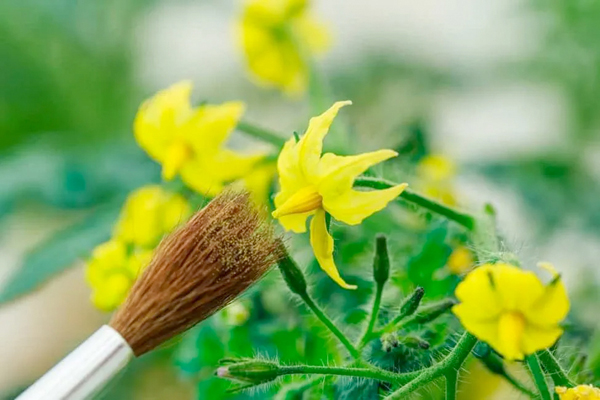
Chapter 15
Tomato Pollination
Pollination is the process of transferring pollen from the male part of the tomato blossom (anther cone) to the female part (pistil), or more specifically, the stigma which is the pollen-receptive tip of the pistil. The pistil is made up of the ovary and a connecting stalk referred to as the style which bears the stigma on its tip. Pollen grains land on the stigma, germinate, and then grow down the style to fertilize the ovules in the ovary – ultimately forming seeds. Pollination is not to be confused with fertilization, which may follow pollination by 24 to 48 hours. Pollination is when the pollen lands on the stigma. Fertilization is the process whereby the pollen unites with the ovules in the ovary to form seed.

Fertilization
Pollen germinates and then fertilizes the ovules best when the temperature is around 85˚ F. Pollen development can be impaired by higher temperatures. Daytime temperatures above 95˚ may actually kill pollen. Fertilization of the ovules may take up to 48 hours. Large-fruited heirloom tomatoes, in particular, have great difficulty setting seed during extended periods of hot weather in the mid to upper 90's, especially if night time temperatures do not drop below 70˚.
Not all pollinated blossoms set tomatoes, as the pollen must first stick to the stigma, then germinate, and finally send tubes (sperm) down the style where they unite with the ovules in the ovary.
When the stigmas are receptive to pollen, they become sticky. However, the anthers do not shed their pollen until at least 24 hours later. During this time, cross pollination can occur. After the anthers begin to shed their pollen, the flower is more likely to be self-pollinated. Tomatoes are for the most part self-pollinated, but cross-pollinations can occur.
The process is as follows: the stigma becomes receptive to pollen; 24 hours later, the anthers shed their pollen, some of which lands on the stigma; in another 24 to 48 hours, the pollen reaches the ovules whereupon the chromosomal material from the pollen enters the ovules.

When it is said that tomatoes are self-pollinating, this means that each blossom contains both a stigma, a style, and an ovary (female parts), and an anther cone (male part). The anther cone surrounds and may enclose the female portion of the blossom. No outside intervention by bees is required for pollination. When the blossom opens, the stigma is receptive to pollen for 24 to 48 hours. The pollen is viable for several days. Pollen simply falls from the anther cone surrounding the stigma onto the stigma. In this manner tomato blossoms will usually pollinate themselves.
Tomatoes set fruit when night time temperatures are between 55˚ and 75˚. If it is too hot or too cold, pollination fails and no tomatoes will set. Pollen is shed most abundantly on bright sunny days between 10 am and 4 pm. You may assist pollination by gently shaking the flower clusters. As the daytime temperature exceeds 90˚, the likelihood of successful pollination decreases. If successful pollination does not occur, the open blossom will usually fall off at the abcission within a few days. If pollination is successful, the ovary will begin to enlarge.
As discussed earlier, large blossoms may require extra pollen as they have a tendency to abort due to inadequate pollination. You can supply that extra pollen by finding another blossom that has just opened, remove its style with small scissors, and then gently rub the anther cone against the stigma of the blossom. This may also be accomplished using the tip of your finger. Simply rub the anther cone of a second blossom onto your finger tip, then gently touch the stigma of the special blossom with the tip of that finger.
Recall that a giant tomato matures on average 70 days after pollination, so a tomato pollinated on July 1st will ripen during the first part of September. Use this method when planning a tomato for an event such as a weigh-off.
Tomato Blossom-Drop
Why do tomato blossoms dry up and fall off without producing fruit? The phenomenon has been given the name "blossom-drop" and occurs if your tomato blossoms are not pollinated and fertilized properly. This is especially true with Megablossoms as they require even better pollination/fertilization conditions than do ordinary blooms. Anything that interferes significantly with the pollination/fertilization process will result in the abortion of tomato blossoms. The plants bloom but fail to set fruit and then the blossoms simply dry up and fall off. There are several reasons blossom-drop occurs. These are related to extremes of temperature and/or humidity. If it is too hot or too cold or too wet or too dry, the result will be blossom-drop and fewer tomatoes.
Grower Comments on Tomato Pollination
"Leave the center flower in each cluster along with the three largest. Many times, the blossoms don't have to be fused to get a big fruit. A lot of mine were just very large blossoms – very fat too. When you see a large tomato that has formed and you look down on it from the very top of its stem, you can see how the blossom looks. If it's double, it looks it. If single, then you will only see one. The irregularity of large tomatoes is caused by the size of the blossom. The biggest blossoms usually have extra stigma and often don't get enough pollen. I like to make sure they pollinate well, so I take another flower (any flower), a whole flower with the stigma removed, and touch that to the flower I am trying to polinate, rubbing it all along the large blossom. If I need more pollen, I take another flower from any plant. It doesn't even have to be the same variety. The tomato will grow just the same." Minnie Z.